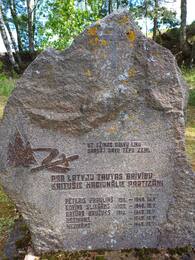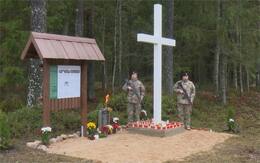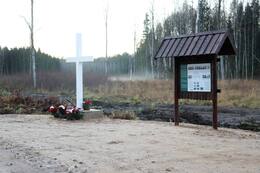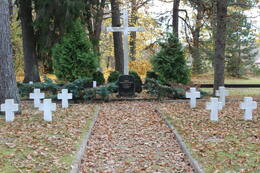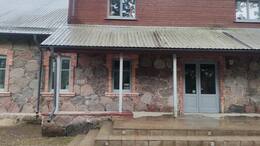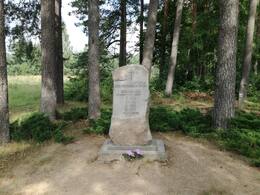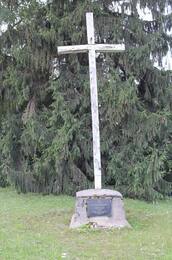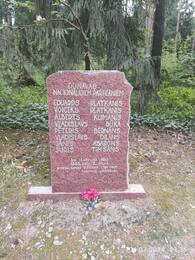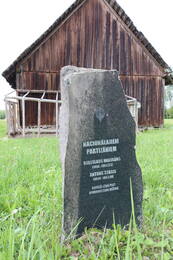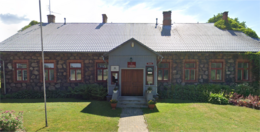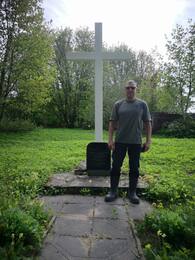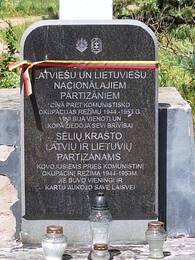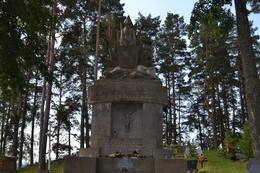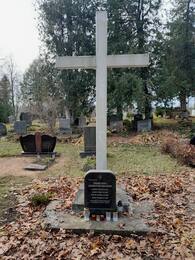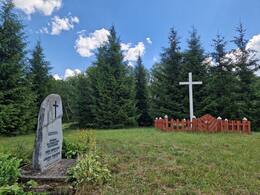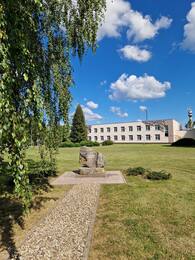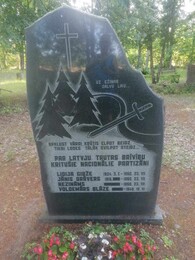Armed resistance to Soviet occupation power in Sēlia
Memorial site to the members of the P. Prauliņš national partisan group and the site of the bunker
Pēteris Prauliņš (1911-1949) Birži parish national partisan group was part of the group led by Mārtiņš Pokļevinskis (1902-1951). The group carried out several partisan actions, in which Soviet collaborators were punished and food and property of the economic institutions of the occupation authorities were requisitioned. P. Prauliņš's group partisans did not observe sufficient conspiracy, many persons visited their settlement, which created an opportunity for betrayal. The lack of military experience was one of the shortcomings of the partisan armed movement.
P. Prauliņš's partisan group in the Kalna forest in the Birži parish was destroyed on May 16, 1949, during an operation by the Ministry of State Security of the Latvian SSR, in which military units also participated. The forest brothers had set up a bunker with perimeter defense, which was well camouflaged and was located at an undetermined height in a swampy area. The partisans fiercely resisted the Cheka troops for at least 40 minutes, but the entire group fell: Pēteris Prauliņš, Artūrs Bružuks, Jānis Kalvāns, Edvīns Slikšāns and Francis Skromanis. The shot forest brothers were thrown near the parish house, but their remains were later buried in nearby gravel pits. Irma Bružuka was seriously wounded, who was captured and died on May 17 in Jēkabpils Hospital. She was buried outside the cemetery, but when the cemetery was expanded after Latvia regained its independence, a monument was placed on her grave.
A memorial stone to the partisans of P. Prauliņš' group in Kalna parish was consecrated in November 1998. The site of P. Prauliņš' bunker is located in section 4 of Vidsala 99th block, Kalna parish. The stone on which P. Prauliņš sat has been preserved.
Memorial site to the members of the J. Indāns - J. Grāvelsons and M. Pokļevinskis national partisan groups
An information stand and memorial site for the Indāns - Grāvelsons national partisan group in Kalna parish, Jēkabpils region, in the vicinity of Sūpes purvas, was opened on Lāčplēsis Day - November 11, 2019. Representatives of Jēkabpils region and Viesīte region, former national partisan H. Miezīte, historian H. Bruņinieks, as well as guests from Lithuania and other interested parties participated in its opening. The memorial site and stand are located near Sūpes purvas, which is associated with the sites of national partisan settlements and battles. Deeper in the forest was also the bunker of the Indāns-Grāvelsons group.
After the deportations of the Latvian population on March 25, 1949, the national partisan supply system was destroyed. From the summer of 1949 to mid-1952, the national partisan movement in the Aknīste, Sauka, Elkšņi, Birži and Viesīte areas experienced its decline, as it suffered from ethnic cleansing and regular counterattacks by the Soviet army and security institutions. The settlement of the national partisan group of Jānis Indāns and Jānis Grāvelsons in the Elkšņi forest in the winter of 1949-1950 had a very serious defense system, uncharacteristic for that time, which did not exist anywhere else in Latvia or in its neighboring country Lithuania in the 1950s. The bunker of the Indāns-Grāvelsons group had specially created perimeter defense trenches and gun nests. Along with the partisans' military readiness to sacrifice their lives in the fight against the enemy, it is also possible to speak of their special identity, which was also manifested in the involvement of other family members in the ranks of the national partisans.
The Indāns-Grāvelsons joint partisan group consisted of 12 people, including five women and one Lithuanian partisan: Jānis Indāns, Jānis Edvards Grāvelsons, Alma Grāvelsone, Pēteris Indāns, Kristīne Indāne, Milda Ārija Indāne, Vasilijs Sokolovs, Voldemārs Otto Sātnieks, Jānis Ķepiņš, Hilda Vietniece, Artūrs Snikus, Jons Žukauskis. Their last battle took place on February 25, 1950, in the Elkšņu Forest, when 11 partisans fell in battle against disproportionately strong forces. Only Hilda Vietniece (Miezīte) survived, who was captured and later spent six years in prison in the Gulag camps.
Memorial site at the site of the national partisan battle of February 13, 1945 in the Diamond Forest of Kalna Parish
The memorial site was created on the regional road P74 Siliņi - Aknīste, 12 kilometers from Aknīste, turning onto the Latvian State Forest "Žagari ceļa".
The vast forest massif of the northern part of Elkšķi parish already at the end of the summer of 1944 became a gathering place for people who were preparing for armed struggle against the Soviet occupation power. At the end of 1944, national partisan groups began to form in the Aknīste area. A suitable place for establishing a partisan camp was the Diamond Forest , which was located on the southern edge of the Elkšķi large forest, near the Aknīste Great Swamp. There, less than 10 kilometers from Aknīste parish, the national partisans created three winter bunkers for wintering. Communications of the men gathered in the forest were ensured with the support of nearby houses - Baltimores, Gargrodes, Līči, Priedes, Krūmi and residents of other houses, neighbors and partisans.
The partisan battle with the soldiers of the Latvian SSR Ministry of State Security in the Diamond Forest took place on February 13, 1945. The Chekists, having taken hostages, drove them forward to reveal the partisan bunkers. The Forest Brothers, seeing the danger, opened fire, not sparing the hostages. 10 representatives of the Soviet occupation troops, eight national partisans and four hostages fell in the battle. Despite the losses of the Forest Brothers, the Chekists failed to capture the partisan bunkers. The surviving partisans waited for darkness and left the settlement. The Chekist soldiers wounded in the battle, groaning, were unable to leave the battlefield. After this battle, which can be considered the forest brothers' first "baptism of battle", the partisans felt like brothers and the rifle seemed more precious than anything, like the only reliable savior.
The White Cross and information stand in the Diamond Forest were installed on Lāčplēsis Day - November 11, 2022. The creation of the memorial site was supported by the Jēkabpils regional government, the association "Tēvzemes sargi" and the Latvian State Forests. The author of the content of the information stand is historian Haralds Bruņinieks.
Cemeteries of the National Partisans of Sēlia
The Sēlija National Partisan Brothers Cemetery was opened on October 30, 2004 with the support of the Latvian Ministry of Defence and the Aknīste Municipality. The partisans who fell in the battle of December 19, 1949 in the Dimantu Forest of Kalna Parish are buried there: Alberts Karankevičs (1914-1949), Vilis Tunķels (1911-1949), Arnolds Tunķels (1926-1949), Osvalds Tunķels (1929-1949), Ēvalds Kundzāns (1927-1949).
In 2005, the partisans who fell in the battle of February 13, 1945 in the Elkšņi Forest were also reburied here: Juris Alfreds Voldemārs Lācis (1908-1945), Eduards Kaminskis (1910-1945), Osvalds Mežaraups (1911-1945), Alberts Mežaraups (1915-1945), Antons Bružiks (1911-1945), Jānis Britāns (1926-1945) and one unknown. The common cemetery also contains the remains of Marta Mežaraupe (1907-1945), Alberts Lācis (1902-1945), Juris Resnītis (1901-1945) and Pēteris Bite (1907-1945), who were taken hostage by the Soviet occupation authorities and fell during the battle, as well as Voldemārs Otto Sātnieks (1911-1950), a fallen partisan of the Indāns-Grāvelsons group. The Aknīste Brothers' Cemetery also houses a monument to Alfreds Silaraup (1925-1946), a national partisan of the Aknīste Company, who fell during a Cheka operation on July 30, 1946, on the narrow-gauge railway in the Elkšņu Forest.
At the foot of the White Cross erected at the Brothers' Cemetery of the National Partisans of Sēlija, a black granite stele with the emblem of the Latvian National Partisan Association and the text engraved below it, "To the National Partisans of Sēlija. You sacrificed your lives for Latvia in the fight against the communist occupation regime in 1944-1954." There is also a memorial stone in the cemetery with the inscription "There are tears that will be shed in silence. There are scars that will not heal when healed," which was erected by Stanislava Šadurska at the beginning of the Awakening near the pit where the Chekists buried the national partisans and hostages who had fallen the day before on February 14, 1955.
Former Susēja parish house, site of attack by national partisans on July 7, 1945
Today, the former Susėja parish house houses the Sanssouci residence center. The facade of the building still bears traces of the attack left by bullets fired by national partisans during the attack on July 7, 1945.
The former Susēja parish house, which at that time functioned as the local executive committee of the Soviet occupation authorities, suffered an attack by the Sēlija national partisans on July 7, 1945. The attack on the Susēja executive committee was part of a wider national partisan campaign and took place simultaneously with the attacks on the Vilkupe butter factory and the house of the destroyer Kaunackas.
According to the instructions of the commander of the Susėja national partisan group, Albert Kaminskis (1920-1946), the Forest Brothers were to destroy the security of the local executive committee, take weapons, militia uniforms, documents and damage telephone communications. About 17 Forest Brothers under the leadership of the Lithuanian partisan commander Jozas Kuveikis participated in the attack on the Susėja executive committee. The battle lasted 15-20 minutes, one Lithuanian partisan fell during the firefight, and on the other side - a fighter of the destroyer battalion Jānis Kakarāns. During the firefight, the windows of the executive committee were broken and the telephone was damaged.
The second attack on the Susēja Executive Committee took place on July 16, 1945, when a prolonged firefight took place between the Forest Brothers and fighters of the destroyer battalion who had sought refuge in the Executive Committee building. During the battle, a group of Soviet soldiers came to the aid of the latter, who opened machine-gun fire from the flank and forced the partisans to retreat. At least five Forest Brothers and five destroyers fell in the battle. The attacks on this administrative object of the occupation power confirmed the nature of the armed resistance of the partisan war and were a warning about the people's resistance to the Soviet occupation power.
Monument to the National Partisans of Susėja
The Susēja national partisan unit was formed from smaller fragmented forest brotherhood groups, because initially there was no leader who could unite them. For a short time, Artūrs Grābeklis tried to coordinate the activities of the Susēja partisans, and later Markejs Gorovņovs, who fell in the winter of 1945. The Susēja national partisan unit was strengthened after the former legionnaire Alberts Kaminskis arrived in Courland, Sēlija, after the general capitulation of Germany. He established stricter discipline and united smaller groups for a joint fight against the Soviet occupation power. Cooperation was also established with forest brotherhood groups from nearby parishes and areas, especially with the Gārsene group and Lithuanian partisans who had settled on the border of Lithuania and Latvia.
In the early stages of the armed movement, it is clear that the Forest Brothers were not prepared for attacks, unable to occupy either the Kaunacki farmstead or break into the building of the Susėja executive committee. The partisans suffered losses and were unable to resist the Cheka troops for a long time, and the main method of fighting was to think about retreating in time. There was also a problem with the supply of the partisans. Despite the existing difficulties, the Susėja national partisan unit was still able to actively resist the Soviet occupation power in the first post-war years. This partisan group ceased to exist after the fall of its commander A. Kaminskis on May 14, 1946. This was also followed by the legalization of several Forest Brothers, as well as joining other partisan groups.
The monument to the national partisans of the Susēja company was opened on November 11, 1997, at the initiative of Gunārs Blūzmas, a researcher of the history of the national partisans of Sēlija. Next to the names of the fallen Susēja national partisans, a text is carved into a roughly worked boulder under the sign of a cross: “On the head of a hedgehog, I ordered you to protect your father’s land.” The monument mentions those who fell in the attack on the Susēja executive committee on July 16, 1945 - Jānis Grābeklis (1923-1945), Ādolfs Rācenis (1919-1945), Broņislavs-Arvīds Bīriņš (1919-1945) and Edgars Ērglis (1920-1945), and later the names of the murdered Līna Kaminska (1917-1945) and Albert Kaminskas (1920-1946) were added. The monument is missing the names of Arnolds Dombrovskis (1923-1945) and other national partisans who were active in the Susēja national partisan groups and who fell in 1945-1946.
Memorial to Latvian and Lithuanian national partisans in Slate
The white cross with a stele to the Slate national partisans in Rubene parish was consecrated on October 25, 2002.
It was a joint group of Latvians and Lithuanians led by Jāzeps Fričs (1920-1947). The group also included Lithuanian partisan commander Jozas Streikus (1923-1962), Jānis Ruzga (1924-1948) and other national partisans who actively resisted the Soviet occupation regime in the Slates and surrounding parishes.
Memorial at the site of the July 2, 1945 battle of the national partisans on the Danube
Memorial stone to the national partisans Jānis Abaronas, Vladislavs Būkas, Pēteris Bernāns, Alberts Klimanis, Vladislavs Dilāns and Juris Timšāns who fell in the Battle of the Danube on July 2, 1945 and were later burned in Rubene parish.
The Battle of Dunava broke out after two officers of the People's Commissariat of the Interior of the Latvian SSR and one militiaman were killed in clashes between foresters and representatives of the Soviet occupation authorities in Atauga, Dunava parish, on the evening of June 30 and July 1. On July 2, 16 national partisans led by Eduards Platkanis fought a battle with destroyers, militiamen and Cheka troops at the turn of the Rubene road behind the Dunava cemetery. A few days later, in retaliation, the Cheka officers burned down the houses of Atauga, and publicly burned the bodies of six national partisans who had fallen in the Battle of Dunava near the Rubene parish hall.
Monument to national partisans B. Mikulas and A. Staris
The monument to the national partisans Boleslavs Mikulāns (1918 - 1951) and Antons Staris (1909 -1953) of the Ilūkste Partisan Regiment of the Latvian Fatherland Guards (Partisans) Association was unveiled on November 1, 2003, at the “Kuršu” farm in Celminiekis, Dunava parish, at the initiative of Gunārs Blūzma, a researcher of national partisans from Sēlija.
B. Mikulāns from August 1944 was active in various national partisan groups, including the Bebrene company and the Dignāja group in 1949. In 1949/1950. B. Mikulāns, together with A. Stari, hid with Jānis Brakovka in Curonian Spit on the edge of the large forest of Bebrene Celminieki. When B. Mikulāns went to get products on May 9, 1951, he was murdered by Švarojs, an officer of the 2-N unit of the Cheka. A. Stari committed suicide in March 1953 after Curonian Spit was surrounded by Cheka officers.
On a memorial stele made of granite, next to the names of the fallen national partisans B. Mikulāns and A. Staras, the inscription is engraved: "Fallen in the fight against the communist regime."
Rubene parish house - a place of Cheka repressions
Rubene parish hall, near which the Chekists burned the bodies of six national partisans who fell in the Battle of the Danube on July 2, 1945. For the purpose of intimidation, the employees of the Rubene parish hall were also forced to watch this action.
A cross and an inscription are carved on the memorial stone:
"I am dying for faith and free Latvia. Jānis Abarons, Vladislavs Būka, Pēteris Bernāns, Alberts Klimanis, Vladislavs Dilāns, Juris Timšāns fell and were burned in the battle of July 2, 1945."
Memorial to J. Fričis Latvian and Lithuanian National Partisan Group at Emsini Cemetery
White cross with a stele in Asare parish at the Emsiņi cemetery at the beginning of the alley. Consecrated on September 10, 2005.
Dedicated to the commanders of the Latvian-Lithuanian national partisan group in the fight against the Soviet occupation power.
The names of Oskars Kalnietis (1915-1945) (who fell on January 10, 1945 near Dīviņas) and Jāzeps Fričis (1920-1947) (who fell on September 7, 1947 in Abarkalni) are engraved on the memorial stele.
The hiding place of the national partisan A. Blumbergs
Not only the forests of Latvia, but also the houses still hide information about the tactics and methods of the national partisans' struggle. The forest brothers' hideouts have not survived in Latvia, so this is a unique discovery, which also gives it cultural and historical significance. The national partisans were mostly men in their prime, with a desire to build relationships with the opposite sex. They would hardly have been able to endure all the difficulties if they had not had the support of a woman standing by their side in the fight. This helped to endure the severity of the partisan war, which was often also based on the consciousness of being doomed to death. Unfortunately, most of these relationships were tragic.
Alfreds Blumbergs (1917-1949), being in the Forest Brothers group, maintained a romantic relationship with Milda Purene (1913-2010), a resident of Gārsene parish, from whom he received food, which also became known to the Soviet security authorities. On July 27, 1949, a military unit of the Ministry of State Security of the Latvian SSR set up a hideout in the yard of the Puķīši houses in Gārsene parish. Forced to cooperate with the Cheka, M. Purene betrayed Alfreds Blumbergs, who fell during the Cheka operation against him.
Memorial to Latvian and Lithuanian national partisans in Prode parish
White cross with a stele for Latvian and Lithuanian national partisans in Prode parish. Erected at the place where the Chekists buried the bodies of fallen national partisans in gravel pits. The memorial is dedicated to several hundred Latvian and Lithuanian national partisans who resisted the Soviet occupation.
The inscription on the stele in Latvian and Lithuanian reads: "Hail to the Latvian and Lithuanian national partisans. In the fight against the communist occupation regime in 1944-1953, they were united and together sacrificed themselves for freedom."
The memorial site was consecrated on September 5, 2007. It was improved and supplemented with a memorial plaque on April 24, 2013, with the participation of the Commander of the Latvian Armed Forces, Lieutenant General Raimonds Graubes, and the Commander of the Lithuanian Armed Forces, Lieutenant General Arvīdas Pocius, and other representatives of the armed forces of both countries. The memorial site was established by the Latvian National Partisan Association together with the Lithuanian Freedom Fighters Association, in cooperation with the Subate and Obelis municipalities.
Memorial to Latvian and Lithuanian national partisans at the Sārtene Cemetery
Driving along the Ilūkste–Subate road, 5 km from Eglaine, motorists' attention is drawn to the sign "Sārtene Cemetery" ("Červonka Cemetery"). Following this sign, we see a White Cross and a stele installed at the edge of the cemetery, at the foot of which we read the inscription in Latvian and Lithuanian: "For you, Fatherland. To the Lithuanian company of Ilūkste national partisans" and further we read the names of the Lithuanian national partisans who fell in the fight against the Soviet occupation regime on June 25 and September 28, 1945.
Walking further into the cemetery area, travelers are drawn to the monument erected in 1932 to the fallen Lithuanian soldiers, whose remains were reburied here in 1931. For several decades now, the Lithuanian border town of Rokiškis has been actively involved in maintaining this memorial site, paying tribute to its compatriots who fell in the fight for freedom and independence. The Lithuanian Soldiers' Cemetery Volunteer Association and its chairwoman Rimante Narvaišienė have taken special care of maintaining the cemetery in order and organizing commemorative events for more than 25 years. Although the old lady has been gone for several years now, the traditions continue.
The 6.5 m high monument was built in 1932 with Lithuanian state funds. The monument is crowned by the figure of a virgin - a symbol of Lithuania, holding a plaque with a bas-relief of St. George, at her feet a fallen soldier with a rifle next to him. At the bottom center is an image of the crucified Christ.
The monument was created by Lithuanian sculptor Stasis Stanišauskas.
Memorial to the national partisans who fell in the battle of August 4, 1945, at the Ludvigova Cemetery in Pilskalne Parish
White cross and stele in the Ludvigova cemetery in Pilskalne parish.
Bebrene Company Commander Salimons Gabris (1916-1945) and national partisans Alberts Strods (1925-1945), Staņislavs Voitiškis (1903-1945) and Ludvigs Tamanis (1917-1945), whose names can be read on the memorial stele, fell on August 3 (4), 1945 near Ludvigova, while leading Lithuanian envoys to the Ilūkste Regiment headquarters.
The memorial site was consecrated on August 5, 2005 by the prelate of the Ilūkste Catholic parish, Jānis Krapāns.
Monument to national partisans J. Medveckis and G. Vanadziņš
The monument was erected at the site of the last battle of the national partisans Juris Medveckas (1924-1947) and Gunārs Vanadziņš (1926-1947) near the Timšāni house in Pilskalne parish.
J. Medveckis served in the Latvian Legion during World War II, was awarded the Iron Cross, 2nd class, for his heroism in battle, but later joined the Sēlija national partisans. G. Vanadziņš avoided mobilization into the Red Army in September 1944, joined the Forest Brothers unit of Albert Kaminskis (1920-1946), but after the disintegration of the Susēja group, he worked in the national partisan group of Jāzeps Fričis (1920-1947). Later, together with J. Medveckis, he took part in several actions against the Soviet occupation power.
The monument contains the names of the national partisans who fell on December 1 (2), 1947, and the inscription: "I placed them on a hedgehog's head. Protect your Fatherland. To the national partisans of the Danube. Fallen in battle with the Cheka troops."
Memorial to the Dviete Company of the Ilūkste National Partisan Regiment
The Dviete National Partisan Company was formed in April 1945 under the leadership of former Latvian Army Deputy Officer Otto Sudrabiņš. The company consisted of four platoons, formed by residents of Dviete, Pilskalne, Bebrene and Dunava parishes. On the night of June 16/17, the partisans of the Dviete Company fought a battle with representatives of the Soviet occupation authorities near Jadvigova, freeing two partisan supporters who had been taken prisoner and killing eight local militiamen and destroyers. In June, the Dviete Company was included in the 1st Battalion of the Ilūkste Partisan Regiment, commanded by former Latvian Army Deputy Officer Staņislavs Urbāns, and under the leadership of former legionnaire Jānis Stūriškas. The composition of the company constantly changed, at different times it included about 70 national partisans, including women.
In August 1945, the Ilūkste partisan regiment was included in the 2nd division of the Latvian Fatherland Guards (Partisan) Association. On the night of September 27/28, a 25-man partisan unit formed from the headquarters company of the Ilūkste partisan regiment and the Dviete company cut the lines of communication with Ilūkste and Bebrene, but then occupied the Dviete executive committee and the police station, as well as blocked the house of the destroyer Vuškāns and requisitioned goods from the local store. The Dviete company as a separate unit ceased to exist in early 1946, when, with the loss of hope for help from Western countries, a large part of the Ilūkste regiment partisans legalized themselves, however, some of them continued their resistance to the Soviet occupation power until 1955.
The memorial stone for the Dviete Company of the Ilūkste Partisan Regiment of the Latvian Fatherland Guards (Partisans) Association was unveiled on July 10, 2010. Its design was developed by Gunārs Blūzma, a researcher of national partisans from Sēlija, and the monument was forged by Imants Laizāns, a stonemason from Jersika. The inscription on it reads: “On September 27/28, 1945, national partisans occupied Dviete and temporarily suspended the Soviet occupation. For You, Fatherland.”
Memorial to the fallen members of J. Grāvers' national partisan group at the Slīterāni cemetery
Memorial stele to the fallen members of the J. Grāvers group of national partisans Lidija Gibže (1924-1950), Jānis Grāvers (1915-1950), Voldemārs Blāzes (fallen in 1948) at the Slīterāni cemetery in Dignāja parish, opened in 2000.
The stele contains the names of the national partisans who fell in battle with the Cheka special group and the inscription "I put them on a hedgehog's head... Words fall silent, chests stop breathing. Only bullets rush further, whistling... National partisans who fell for the freedom of the Latvian people."




